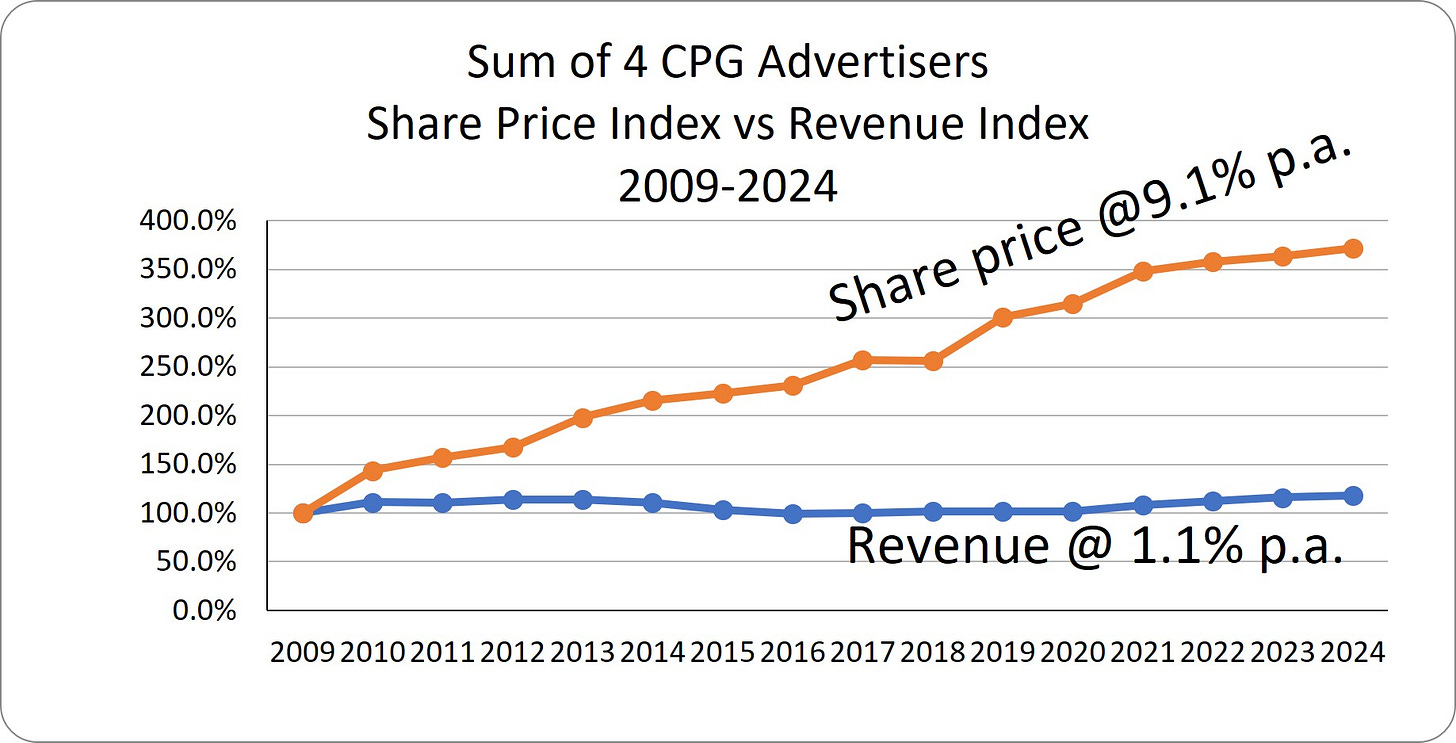Madison Avenue Can Transform Itself -- if Marketers and Agencies Agree to Solve the Real Problem Plaguing their Relationships
The industry has pursued "low cost" digital / social solutions," when the real problem is the lack of brand growth for the past 15 years.
Credit: Sam Gross, The New Yorker, The Cartoon Bank
Advertisers and their agencies should have a common interest in transforming their relationships — the current way they work with one another is not creating value for either party:
Advertisers’ legacy brand growth slowed significantly 15 years ago despite massive investments in digital / social media. Forty percent of major advertisers now have brand growth rates below GDP growth.
CMOs became an endangered species — replaced frequently with executives with evolving job titles (Chief Growth Officer, Chief Revenue Officer, Chief Customer Officer, Chief Experience Officer, Chief Brand Officer). CMOs have been trying to solve the wrong problem, seeing more low-cost digitalization of marketing as the desired path — even though there is little evidence that this works.
Simultaneously, media and creative scopes of work ballooned, growing faster than fees paid to agencies, putting enormous pressure on agency resources. Creative outputs increased from 10-20 ads per year per creative to 200-300 ads per year, reducing the quality and effectiveness of agency outputs.
Long-term relationships disappeared, replaced by a never-ending cycle of agency reviews and RFPs that lowered advertiser costs, raised agency pitching costs but did little to improve marketing quality or to stimulate brand growth.
Lower cost, rather than higher value, became the dominant objective, with marketing seen as a cost to be reduced rather than as an investment to be optimized and celebrated.
Agencies, under financial pressure, chronically downsized to maintain margins, liquidating talent and senior expertise.
Does anyone think that this is the right way to run a railroad?
The Brand Growth Problem is an “original sin” problem. All of the other Madison Avenue problems stem from the failure of legacy brands to grow for the past 15 years.
******************************************************
A slowdown in legacy brand growth began in 2009, immediately after the global financial meltdown and on the eve of the digital / social revolution.
Previously, CPG advertisers had been growing at 6-8% per year for 48 years!
That growth rate came to a screeching halt in 2009.
To illustrate the slowdown, let’s look at the combined sales of P&G, Unilever, Nestle and Colgate Palmolive from 2009 through 2024 (source: www.macrotrends.net). Together, these major CPG advertisers grew their revenues at only 1.1% per year while GDP grew at double this rate.
The evolution of marketing mix to digital / social advertising was not the only thing going on during this period. These companies each made fewer acquisitions, carried out less new product development, experienced the coming of age of Gen Z and incurred more competition from private label brands. Legacy brands are now “premium priced” brands on retail shelves, but there is nothing in their marketing mix that justifies their premium pricing — why should today’s consumers buy high-priced goods unless they have a good reason to do so?
Top of mind for the CEOs and CFOs of these companies is the maintenance of share price growth, and in this they succeeded — through extreme cost reductions (driven by procurement and finance), share buy-backs and other financial engineering means, like dividend increases. Had revenue growth been higher, though, share prices could have risen much faster than 9.1% per year.
Can the brand growth problem be solved?
Yes. To do so, marketers and their agencies need to solve four major problems:
Redefine the mission of their working relationship. “Our joint mission is to rekindle and maintain brand growth through the effective use of media and creative solutions.” This means that both parties need a shared understanding of the performance of each brand and the reasons for the reduction in brand growth rates.
(Today, brands rarely share their brand strategic plans with agencies, seeing agencies as “temporary vendors” rather than as strategic partners.)
Jointly design media and creative scopes of work that address the brand growth problem. It’s not good enough to greenlight scopes of work that are “more digital, more social, more programmatic, more targeted and lower cost,” which seems to be the way SOWs are designed today. Instead, there’s a need to develop media and creative SOWs that have the highest probability of rekindling brand growth.
(The use of Marketing Mix Modeling (MMM) programs can provide helpful guidance to CMOs who are understandably overwhelmed by the complexity of today’s media possibilities. Mutinex is high on my personal list of MMM programs that can help CMOs in this way.)
Structure agency remuneration based on the size and complexity of the SOWs, not on a guesstimate of agency man-hours. In other words, pay agencies for their outputs, and once agencies have proven over time that their work adds value, let them increase the price of their work. This approach will ensure that agency remuneration is fair, allowing for the right mix and number of agency resources, which is certainly not the case today.
(As part of this, though, both advertisers and agencies need to begin to document and quantify their SOWs for remuneration purposes. This is not done in a systematic or professional way today. Poor joint SOW management is a major shortcoming in most advertiser-agency relationships. I’ve developed ScopeMetrics® as a helpful tool for better SOW management, and it can be used in conjunction with popular client-side platforms like Decideware).
Restructure agency teams around senior brand strategists and analysts, who need to have access to appropriate data. As AI begins to displace those junior agency folks who crank out media / programmatic plans or hundreds of ad banners, email messages, online videos and keyword searches, agencies need to replace them and invest in consulting-like senior people who can carry out brand strategic analyses to drive SOW design and AI work. These senior people were downsized over the last 15 years — there are too few of them for the forthcoming AI era.
(The freelance marketplace is awash with experienced ex-management consultants — Umbrex is a great source — and there are certainly plenty of experienced media strategists and senior creatives continuing to work on a freelance basis. Upgrading the structure of agency teams is essential for the success of any brand growth programs.)
All of this is within reach of CMOs and senior agency executives, but it requires strong, committed leadership and a belief that without these changes, the industry will implode from its own wasteful ineffectiveness.
The industry has brand growth problems, SOW problems and agency price / staffing problems, and none of these can be solved through an obsessive focus on carrying out ineffective work within an ineffective media mix at the lowest possible cost .





